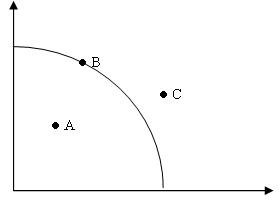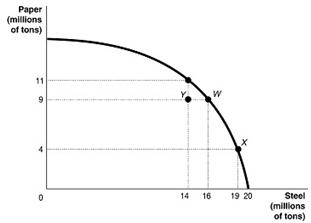 |
| 1 |  | 
When is it rational to hire outside help rather than do a task yourself? |
|  | A) | When opportunity cost is greater than hired cost |
|  | B) | When opportunity cost is less than hired cost |
|  | C) | When opportunity cost is equal to hired cost |
|  | D) | It is always better to do the task yourself |
|
|
 |
| 2 |  | 
Which of the following principles explains specialization and trade? |
|  | A) | The principle of absolute advantage |
|  | B) | The low hanging fruit principle |
|  | C) | The principle of comparative advantage |
|  | D) | The principle of increasing opportunity cost |
|
|
 |
| 3 |  | 
If you want to represent the relationship between the quantity of product X and the opportunity cost of product Y graphically, the curve would be: |
|  | A) | Vertical |
|  | B) | Upward sloping |
|  | C) | Horizontal |
|  | D) | Downward sloping |
|
|
 |
| 4 |  | 
Questions 14 to 16 relate to the following table:
You are given the following preparation times for Farah and Sarah:
 <a onClick="window.open('/olcweb/cgi/pluginpop.cgi?it=jpg::::/sites/dl/free/007712961x/946031/2_14.JPG','popWin', 'width=NaN,height=NaN,resizable,scrollbars');" href="#"><img valign="absmiddle" height="16" width="16" border="0" src="/olcweb/styles/shared/linkicons/image.gif"> (9.0K)</a> <a onClick="window.open('/olcweb/cgi/pluginpop.cgi?it=jpg::::/sites/dl/free/007712961x/946031/2_14.JPG','popWin', 'width=NaN,height=NaN,resizable,scrollbars');" href="#"><img valign="absmiddle" height="16" width="16" border="0" src="/olcweb/styles/shared/linkicons/image.gif"> (9.0K)</a>
Based on the table above, who has an absolute advantage? |
|  | A) | Farah has an absolute advantage in both pizza and burger |
|  | B) | Sarah has an absolute advantage in both pizza and burger |
|  | C) | Farah has a comparative advantage in burger |
|  | D) | None of the above |
|
|
 |
| 5 |  | 
In an 8 hour day, which of the following is true? |
|  | A) | Farah's opportunity cost of preparing 1 pizza is ½ a burger |
|  | B) | Sarah's opportunity cost of preparing 1 burger is 1½ pizzas |
|  | C) | Farah's opportunity cost of preparing 1 burger is 2 pizzas |
|  | D) | Sarah's opportunity cost of preparing 1 pizza is 1½ burgers |
|
|
 |
| 6 |  | 
Based on the table above, Farah has a comparative advantage in: |
|  | A) | Burger |
|  | B) | Pizza |
|  | C) | Both |
|  | D) | None |
|
|
 |
| 7 |  | 
Which of the following is true regarding the production possibilities curve (PPC) presented below?
 <a onClick="window.open('/olcweb/cgi/pluginpop.cgi?it=jpg::::/sites/dl/free/007712961x/946031/2_17.JPG','popWin', 'width=NaN,height=NaN,resizable,scrollbars');" href="#"><img valign="absmiddle" height="16" width="16" border="0" src="/olcweb/styles/shared/linkicons/image.gif"> (4.0K)</a> <a onClick="window.open('/olcweb/cgi/pluginpop.cgi?it=jpg::::/sites/dl/free/007712961x/946031/2_17.JPG','popWin', 'width=NaN,height=NaN,resizable,scrollbars');" href="#"><img valign="absmiddle" height="16" width="16" border="0" src="/olcweb/styles/shared/linkicons/image.gif"> (4.0K)</a> |
|  | A) | Point A represents an attainable, efficient outcome |
|  | B) | Point C represents an attainable, inefficient outcome |
|  | C) | Point B represents an attainable, efficient outcome |
|  | D) | Point B represents an attainable, inefficient outcome |
|
|
 |
| 8 |  | 
The following table represents production possibilities for an imaginary economy for a given year
 <a onClick="window.open('/olcweb/cgi/pluginpop.cgi?it=jpg::::/sites/dl/free/007712961x/946031/2_18.JPG','popWin', 'width=NaN,height=NaN,resizable,scrollbars');" href="#"><img valign="absmiddle" height="16" width="16" border="0" src="/olcweb/styles/shared/linkicons/image.gif"> (4.0K)</a> <a onClick="window.open('/olcweb/cgi/pluginpop.cgi?it=jpg::::/sites/dl/free/007712961x/946031/2_18.JPG','popWin', 'width=NaN,height=NaN,resizable,scrollbars');" href="#"><img valign="absmiddle" height="16" width="16" border="0" src="/olcweb/styles/shared/linkicons/image.gif"> (4.0K)</a>
If the production possibilities frontier is bowed outward, then X is most likely |
|  | A) | 120 |
|  | B) | 130 |
|  | C) | 160 |
|  | D) | 180 |
|
|
 |
| 9 |  | 
Which of the following statements is / are true of the production possibilities curve (PPC)?
- The PPC is typically bowed outward due to the principle of increasing opportunity cost
- The PPC assumes that the prices of the products are equal
- The PPC assumes that once an efficient combination is attained, you can produce more of one good only by producing more of the other good
- The PPC is based on a fixed level of resources and technology
|
|  | A) | Statement 3 only |
|  | B) | Statement 1 and 2 |
|  | C) | Statement 1 and 4 |
|  | D) | All of the above |
|
|
 |
| 10 |  | 
The following is a production possibilities curve (PPC) of an imaginary economy.
 <a onClick="window.open('/olcweb/cgi/pluginpop.cgi?it=jpg::::/sites/dl/free/007712961x/946031/2_20.JPG','popWin', 'width=NaN,height=NaN,resizable,scrollbars');" href="#"><img valign="absmiddle" height="16" width="16" border="0" src="/olcweb/styles/shared/linkicons/image.gif"> (6.0K)</a> <a onClick="window.open('/olcweb/cgi/pluginpop.cgi?it=jpg::::/sites/dl/free/007712961x/946031/2_20.JPG','popWin', 'width=NaN,height=NaN,resizable,scrollbars');" href="#"><img valign="absmiddle" height="16" width="16" border="0" src="/olcweb/styles/shared/linkicons/image.gif"> (6.0K)</a>
If the economy is currently producing at point W, what is the opportunity cost of moving to point X? |
|  | A) | 5 million tons of paper |
|  | B) | 3 million tons of steel |
|  | C) | Zero |
|  | D) | 9 million tons of paper |
|
|

